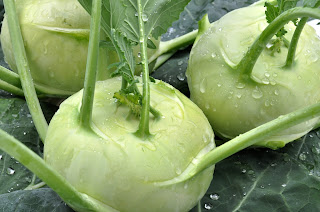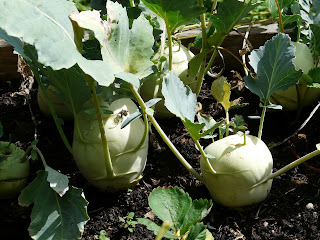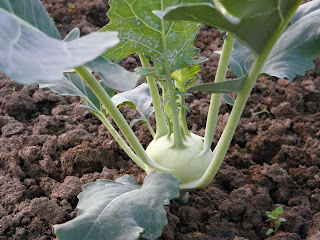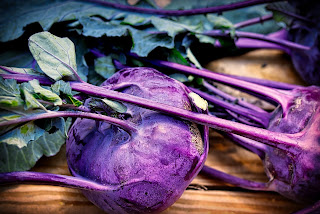horticulture guruji
Knol Khol / Kohlrabi Cultivation
Knol Khol (Brassica oleracea var gongylodes) in India is also known as ‘Ganth Gobhi’. It is a 3rd important cole crop of the Brisicaceae family after cabbage and cauliflower that needs a cool climate for proper growth. In India, it is popular in Kashmir, West Bengal, and Karnataka. In this chapter, you will read in detail about its cultivation.

Other Name:- Ganth Gobhi (Hindi), Kohlrabi.
Botanical Name: – Brassica oleracea var gongylodes (syn. Brassica caulorapa)
Family: – Crucifereae / Brassicaceae
Chromosome No.: – 2n=18
Origin: – Mediterranean region
Edible part: – Knob
Fruit type: – Siliqua
Important Points
- Kohlrabi is the German name of knol khol which mean cabbage turnip.
- Knol khol is a typical biennial crop.
- In India, it is popular in Kashmir, West Bengal, and Karnataka.
- It contains 92.70 gm moisture, 1.10gm protein, 3.8 gm carbohydrates, 1.50 gm fibre,36.00IU Vitamin A and 53.00mg Vitamin C per 100g edible portion.
Watch Lecture Video
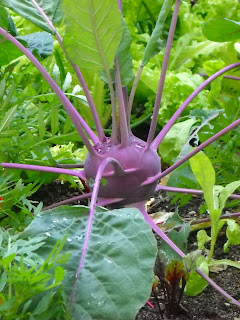
Varieties
Knol khol have about all introduced varieties
- King of North
- Purple Vienna: – Late variety
- White Vienna: – Early variety
- Suttton’s Earliest Purple
- Purple Speck – Early variety
- Golithwhite (Sadashiv)
- Large Green
Climate
In knol khol at low temperature start bolting especially in early varieties is major problems in temperate countries, but it is not in Indian conditions. The optimum temperature for tuber formation is 100-200C. It is more tolerant to frost as compare to others. In North India, it is cultivated as a winter crop (Rabi Crop)
Soil
knol khol is grown in all types of soil but heavy loamy is best for its good yield. The average soil pH range of 6.5-7.0. Knol khol is sensitive to highly acidic and alkaline soil.
Sowing time
|
Varieties |
Time of sowing seed |
Transplanting |
|
Early |
August |
September |
|
Main |
September |
October |
|
Late |
October |
November |
Seed Rate and Seed Treatment
About 1-1.5kg seeds are required to raise nursery for one hectare of land according to season.
Seeds are treated with Thiaram or Captan @2-3 gm/kg seeds before sowing to protect the crop from damping-off in the nursery bed.
Sowing
The seed is sown in raised nursery bed sized 1.2 m wider and 7.5 m long. Generally, Seeds are broadcast on nursery bed. Then apply a thin layer of FYM or compost on the bed to cover the seeds. Seed bed also covered with dry grass mulch. Immediately after sowing light irrigation given to the bed with a rose cane.
Field Preparation
Land should be plough 3-4 time and make soil tilth better. And at the last ploughing add 20-25 t /ha FYM.
Transplanting
The seedlings are ready to transplant 4-6 weeks after sowing. For planting prepare ridge and furrow 30 cm apart. The seedling is planted at 22.5 cm spacing on one side of the ridges. After transplanting crop should be lightly irrigated.
Manure and fertilizers
Generally, 10-15 tonne/ha FYM should be added along with a full dose of P2O5, K2O and half of the N at the time of transplanting or the last ploughing. The remaining dose of N should be given 4 weeks after transplanting. In general, it requires about 100 Kg N, 85 Kg P and 170 Kg K.
Irrigation
The crop should be irrigated 4-7 days interval depending upon the soil and weather conditions. Soil moisture is essential at the time of tuber formation.
Weed Control
As knol khol is shallow-rooted crop so frequent shallow cultivation should be given to the soil to kill the weeds. Spray Pendimethalin@ 1-2Kg/ha pre-emergence then 1-2 hand weeding should enough to control maximum weeds.
Harvesting
The knol khol harvest 45-70 days according to the varieties. Therefore, it is harvested when tuber attains a diameter of 5-7 cm. If delay in harvesting tubers become fibrous.
Yield
The yield of knol khol is about 200 q / ha.
Insect pest management
- Cabbage and turnip aphid (Brevicoryne brassicae):- This insect is more serious during the late season of the crop when it is left for seed production. Insect suck sap from tender plant parts. Later wrinkled, downward-curling of leaves, yellowing of leaves, growth of the plant is reduced, contamination with aphid honeydew is seen on affected plants.
Control
- Spay the crop with Malathion or Parathion in seed production or early stage of plant growth, if the curd is ready to harvest then nicotine sulphate is used to control.
- Dimmond Black Moth (Plutella xylostella):- This is a most damaging pest of cole crops. Larvae of the pest feed on foliar tissue excepts leaf veins due to this photosynthesis process is checked and plant growth is stopped. The dropping of leaves is also starting.
Control
- Grow mustard with the crop as a trap crop
- Spray 4% Neem seed carnal oil.
Disease management
- Damping off (Phythium Or Rhizoctonia sp. Or Fusarium sp.):- Damping-off is a nursery bed disease. In this disease collar region of the seedling start rot and seedling fall on nursery bed resulting death of the seedling.
Control
- Seed should be treated with thiaram or captan 3gm/kg seeds before sowing.
- Drench the soil of nursery bed around the seedling with captan 200 gm/100 litres of water twice.
- Before sowing seeds should be treated with hot water (500C) for 30 minutes.
- Nursery bed should be sterilized with formaldehyde before sowing.
- Downy mildew (Peronospora parasitica):- Initial symptoms are shown on the lower surface of the leaf as purplish-brown spots. Later stage dark sunken spots are seen on the stem.
Control
- Follow crop rotation.
- Kept field weed-free.
- Before sowing seeds should be treated with hot water (500C) for 30 minutes.
- Seed should be treated with thiaram or captan 3gm/kg seeds before sowing.
- Leaf Spot (Alternaria brassicicola):- Small black spots on leaves and stem is seen. The disease is seed as well as soil born.
Control
- Before sowing seeds should be treated with hot water (500C) for 30 minutes.
- Seed should be treated with thiaram or captan 3gm/kg seeds before sowing.
- Nursery bed should be sterilized with formaldehyde before sowing.

